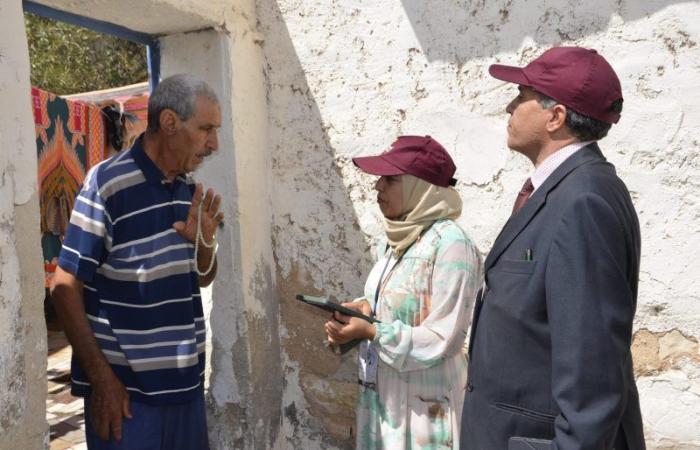JavaScript is disabled! Why you want to do so? Please enable JavaScript in your web browser!
The announcement of the results of the general census sparked comments skeptical of the published figures, particularly on social networks.
For the majority of critical commentators, “the data is wrong”. Some go so far as to claim that “these figures were intentionally underestimated to allow the country to continue to benefit from aid and credits from international institutions, such as the International Monetary Fund and the World Bank”!!.
Among the arguments put forward to contest the HCP figures is that of the population clockwhich currently estimates the population at 37.5 million inhabitantsalmost a million more than the general census figure. So, some are wondering where the million went.
Were the figures underestimated? Does the size of the population have a direct link or impact on lines of credit or funds granted by international institutions?
It is important to understand how the population clock works. This is not a real-time counter which precisely records births and deaths in Morocco. If this had been the case, a general census, mobilizing massive investments in financial and human resources, would not have been necessary.
The clock is based on a projection model based on trends observed during the 2014 census, with the assumption that the population evolves at the same pace over the period 2014-2024. This model therefore projects a statistical estimate, which is displayed on the population clock.
Along the same lines, the HCP explains on its site that “the population figures (on the clock) are based on the last census of 2014, the population projections made by the HCP and the use of statistical algorithms. These projections take into account the evolution of three demographic components: births, deaths and net migration“.
Thus, there is no “disappearance” or “underestimation” of population; the model simply presents a small deviation of 2,22% compared to the real population. A deviation of this order is often considered tolerable, particularly for demographic forecasts where a deviation of less than 5% is generally well accepted.
Note that the population clock had already recorded a similar margin of error in 2014, when its estimates this time turned out to be almost a million people lower than the census results. The birth rate had fallen less than expected. However, no one then suggested that the HCP had “added” a million people to the real population.
Furthermore, international institutions evaluate several criteria for granting funds and lines of credit. Contrary to what is claimed, the size of the population is not a determining criterion. Among the main criteria are the macroeconomic situation, debt sustainability and its management, the performance of institutions, as well as the capacity to implement reforms, the capacity to repay, etc.
HCP data in infographics
Data from the High Commission for Planning (HCP) relating to the 2024 General Population and Housing Census (RGPH) therefore reveal that the legal population of the Kingdom reached, as of September 1, 2024, 36.828.330 inhabitants, including 36,680,178 Moroccans et 148,152 foreigners. Compared to the 2014 census, the population recorded an increase of 2.980.088 inhabitants, i.e. an average annual growth rate of 0,85% for this period, against 1,25% between 2004 et 2014.
The number of foreigners residing in the Kingdom has increased by 61.946 between 2014 and 2024, corresponding to annual growth of 5,6%.
The region of Casablanca-Settat dominates in terms of population, with 7.688.967 inhabitants, or 20,9% of the total population. It is followed by the region of Rabat-Salé-Kénitra, who counts 5.132.639 inhabitants (i.e. 13,9% of the total), and the region of Marrakech-Safi, with a total population of 4.892.393 habitants (13,3%). In contrast, the least populated region is that of Dakhla-Oued Eddahab, with 219.965 inhabitants, representing only 0,6% of the total population of the Kingdom.
La population urban now reached 23.110.108 inhabitants, or 62,8% of the total population, against 60,4% in 2014, marking an increase in 2,4 points compared to 2014. Urban dynamism is particularly visible in regions with high urbanization such as Rabat-Salé-Kénitra (70,7%), Casablanca-Settat (73,3%)Dakhla-Oued Eddahab (80,4%) et Laâyoune-Sakia El Hamrawhere the rate reaches a peak of 92,4%.
La population rural is experiencing limited growth, with an average rate of 0,22%, against 1,24% in the middle urban. This trend reveals a continued rural exodus, particularly during the last decade marked by severe and recurrent droughts, where young people migrate to large cities in search of better opportunities, while rural areas show progressive aging and more rapid growth. slow.
The total number of households also increased to reach 9.275.038 households in 2024, divided into 6.173.930 households urban et 3,101,108 rural areas. The growth in the number of households is accompanied by a decrease in their average size, from 4,6 people per household in 2014 has 3,9 in 2024.
This decline in household size is attributable to factors such as declining birth rates, changing lifestyle choices, and increased urbanization that favors nuclear families. It is also reflected well in the middle urban (from 4.2 to 3.7) than in rural areas (from 5.3 to 4.4), suggesting a transformation in the country’s family structures.
Do you have a real estate project in mind? Yakeey & Médias24 help you make it happen!
© Media24. Any reproduction prohibited, in any form whatsoever, without written authorization from the Société des Nouveaux Médias. This content is protected by law and in particular law 88-13 relating to the press and publishing as well as laws 66.19 and 2-00 relating to copyright and related rights.






